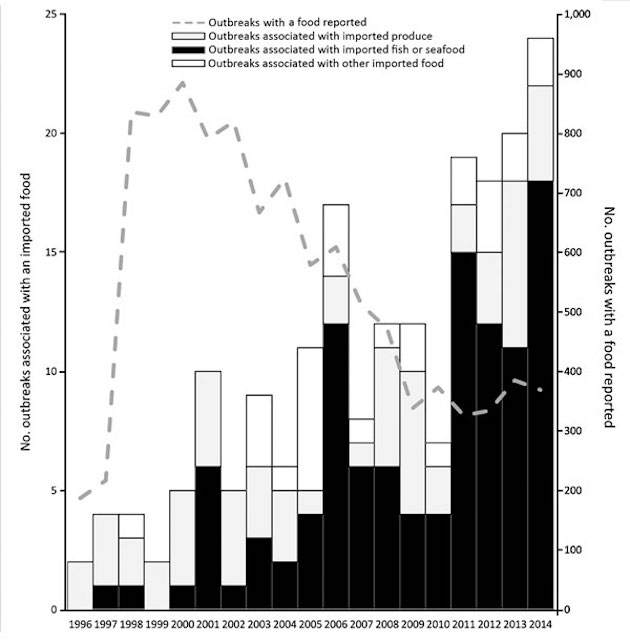
Was it something I ate? <a href="http://www.istockphoto.com/photo/businessman-in-blur-shirt-stomachache-gm517312614-89433313?st=_p_tummy%20ache">5432action</a>/iStock
Overall foodborne illness outbreaks have declined in recent years. But ones that stem from imported foods have risen sharply—from an average of three per year in the late 1990s to 18 annually between 2009 and 2014. That’s the conclusion of a new study from the Food and Drug Administration and the Centers for Disease Control.
A new rule, finalized under President Barack Obama, charges the FDA to ramp up oversight of imports, requiring that importers verify that their suppliers are meeting the same safety standards required of domestic producers, the study notes. The requirement “will help to strengthen the safety of imported foods,” the FDA and CDC researchers write. But providing sufficient funds to enforce that rule now falls to a new president who is openly hostile to regulation and a Congress itching to slash funding to federal agencies like the FDA.
Overall, imported food still has a pretty decent safety record compared to the stuff produced here. About 19.4 percent of the food we eat is imported, yet it accounts for just 5 percent of total outbreaks, the study found. But the situation appears to be getting worse. Back in the 1990s, imports made up 12 percent of the food supply and triggered just 1 percent of recalls. In other words, imported food as a share of what we eat have risen by 62 percent since the 1990s, while the share of outbreaks attributed to imported food has risen by a factor of five.
The study’s authors note that “changes over time should be interpreted cautiously,” because the system for tying outbreaks to particular foods has improved over the past 15 years. It may not be that imports are causing an increasing share of outbreaks over time; it may just be that the authorities are better at pinpointing their causes.
Still, the jump from six outbreaks per year in the 1990s to 18 annually in recent years is troubling. One reason for the jump is that we import lots of the very foodstuffs most likely to cause illness: seafood, of which we import a jaw-dropping 97 percent of what we consume, fresh fruit (about 50 percent imported) and fresh vegetables (about 20 percent). These foods are the culprits for the great bulk of outbreaks from imports:

Interestingly, seafood triggers far more outbreaks, but sickens far fewer people, than fresh produce. “Outbreaks attributed to produce had a median of 40 illnesses compared with a median of 3 in outbreaks attributed to aquatic animals,” the study found.
The difference, according to the prominent food-safety lawyer Bill Marler, of the Seattle-based firm Marler Clark, is that seafood tends to be consumed cooked—which largely kills bacterial pathogens like salmonella—while we generally eat produce raw. A huge shipment of salmonella-tainted shrimp might sicken just a few people, because of our habit of cooking shrimp, while a shipment of similarly tainted lettuce could sicken hundreds or thousands of salad eaters.
Marler added that we shouldn’t think of foreign food as “inherently more risky” than domestic, which is a “jingoistic sentiment.” In reality, he says, “US companies have always done a marvelous job of poisoning our own citizens.” But as the import share rises—particularly of risky foods like seafood and produce—it’s not surprising to see associated outbreaks rise, he says.
That’s why the new rule implemented under Obama, which was required by the Food Safety Modernization Act of 2011 but took years to implement, is so important, says Sandra Eskin, director of The Pew Charitable Trusts’ food safety project. But for the FDA to hold food producers in other countries to US standards requires “money every year, to make sure that companies are complying,” she adds. “The future success of the Food Safety Modernization Act is riding on adequate resources.”
The agency is fully funded through 2017 at Obama-era levels, she says. Whether President Trump and the GOP-dominated Congress are willing to maintain it remains to be seen. The administration has yet to nominate an FDA director, but the rumored short lists brim with libertarian ideologues. That’s not encouraging for people who support robust, properly funded regulation.















